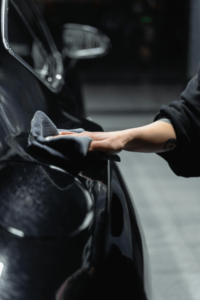Should I Put PPF on My Whole Car?
- Posted January 16th, 2024
- •
- Category: Paint Protection Film
Paint protection film (PPF) is a long-lasting investment in your vehicle. The thin, flexible polymer film hugs the surface of your paint job to form a self-healing barrier that absorbs scuffs and scratches. When expertly applied, PPF keeps your paint looking flawless and new, and allows auto enthusiasts to enjoy their time on the road without the fear of common hazards like highway gravel and door dings.
Because PPF is applied in sheets that are precisely cut to fit the surface of your vehicle, drivers have the option of protecting their entire car or only the most vulnerable areas. Partial PPF comes at an initial cost savings, but, depending on your concerns and plans for your vehicle, it may not offer enough protection.
Advantages of Full PPF
Applying PPF to the entire surface of your car gives you full protection and ultimate peace of mind. Since it’s impossible to guess how every scratch or scrape could happen, bumper-to-bumper film allows you to expect the unexpected.
Whether you own a classic or exotic vehicle, or you just want to maximize resale value, complete protection is your best line of defense against unsightly damage.
Which Areas of Your Car Should You Prioritize?
If you’re on a budget, however, full PPF may not be feasible. Drivers who want to protect their paint at savings may opt to apply PPF to the areas of their car most likely to be impacted by the hazards of daily driving.
Minimal coverage typically involves applying paint protection film to the:
- Front bumper
- Hood
- Fenders
- Door trips
- Side mirrors
- Wheel arches
Ideally, this partial coverage should mitigate damage from road grit, loose gravel, runaway shopping carts, and similar mishaps.
Drawbacks of Partial PPF
If you’re weighing the pros and cons of partial coverage, there are a few potential downsides to consider.
Incomplete Protection
The most obvious shortcoming of partial PPF is that it leaves some areas of your vehicle vulnerable. Less obvious threats (especially those that come from above like falling branches, tree sap, acid rain, or hail) can harm paint in uncovered areas, causing uneven wear.
 Cosmetics
Cosmetics
While expertly applied PPF will be virtually seamless, discerning automotive enthusiasts may still be able to detect where panels of partial PPF begin and end.
Cars with unique finishes like matte or metallic may look particularly conspicuous with an incomplete covering.
More Complicated Care
Using good washing techniques and choosing the right products will go a long way towards extending the life of your PPF. Drivers with partial paint protection film have to be particularly careful of the edges of the sheets so they don’t bubble or peel.
Wax and other car care products can collect around the edges of PPF, drawing attention to seams or causing the film to fail.
Discuss Your Goals with the Paint Protection Experts
Weighing potential savings against the convenience of full PPF? The experts at ATD are available to help you determine what is best for your vehicle and driving situation. Reach out or visit us to discuss your options for paint protection.